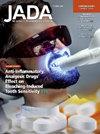俄勒冈州医疗补助计划(Medicaid)中有特殊健康护理需求的儿童因非外伤性牙科疾病使用急诊室的情况。
IF 3.5
2区 医学
Q1 DENTISTRY, ORAL SURGERY & MEDICINE
引用次数: 0
摘要
背景:这项横断面研究评估了有特殊健康护理需求(CSHCN)的儿童是否比无特殊健康护理需求(SHCN)的儿童更有可能因非创伤性牙科疾病(NTDC)而使用急诊科(ED)。该研究还考察了有特殊健康护理需求和无特殊健康护理需求的儿童在NTDC-ED就诊后获得阿片类处方的可能性是否存在差异:本分析基于 2017 年俄勒冈州医疗补助计划的注册、理赔和药房数据(N = 225,614 名 3-17 岁儿童)。为了评估 SHCN、NTDC-ED 使用和阿片类药物处方接收之间的关联,从逻辑回归模型中生成了混杂变量调整后的几率比和 95% CI:结果:约 14% 的儿童(n = 31,867 人)患有 SHCN。所有儿童使用 NTDC-ED 的比例为 0.36%(n = 807)。在混杂变量调整模型中,CSHCN 儿童使用 NTDC-ED 的几率是无 SHCN 儿童的 1.6 倍(95% CI,1.3 至 1.9;P < .001)。在接受过 NTDC-ED 就诊的儿童中,8.3% 接受过阿片类药物处方。在混杂变量调整模型中,CSHCN 在 NTDC-ED 就诊后接受阿片类药物处方的几率低于未接受 SHCN 就诊的儿童,但这一差异无统计学意义(几率比 0.84;95% CI,0.4 至 1.6;P = .57):结论:加入医疗补助计划的 CSHCN 接受 NTDC-ED 就诊的几率明显高于未加入 SHCN 的儿童,但在接受 NTDC-ED 就诊后获得阿片类药物处方的几率方面,两组之间没有明显差异:实际意义:所有儿童,尤其是患有 SHCN 的儿童,都应通过牙科之家获得足够的诊室口腔保健服务,以减少因 NTDC 而使用急诊室。本文章由计算机程序翻译,如有差异,请以英文原文为准。
Emergency department use for nontraumatic dental conditions for children with special health care needs enrolled in Oregon Medicaid
Background
This cross-sectional study evaluated whether children with special health care needs (CSHCN) were more likely to use the emergency department (ED) for nontraumatic dental conditions (NTDCs) than children without special health care needs (SHCN). The study also examined whether the likelihood of receiving an opioid prescription after an NTDC-ED visit differed between children with and without SHCN.
Methods
This analysis was based on 2017 Oregon Medicaid enrollment, claims, and pharmacy data (N = 225,614 children aged 3-17 years). To assess associations between SHCN, NTDC-ED use, and receipt of opioid prescriptions, confounding variable–adjusted odds ratios and 95% CIs were generated from logistic regression models.
Results
Approximately 14% (n = 31,867) of children had an SHCN. The prevalence of NTDC-ED use was 0.36% (n = 807) for all children. In the confounding variable–adjusted model, the odds of NTDC-ED use were 1.6 times greater for CSHCN than children without SHCN (95% CI, 1.3 to 1.9; P < .001). Among children with an NTDC-ED visit, 8.3% received an opioid prescription. In the confounding variable–adjusted model, CSHCN were at lower odds of receiving an opioid prescription after an NTDC-ED visit than children without SHCN, but this difference was not statistically significant (odds ratio, 0.84; 95% CI, 0.4 to 1.6; P = .57).
Conclusions
CSHCN enrolled in Medicaid had significantly higher odds of having NTDC-ED visits than children without SHCN, but there was no significant difference between the 2 groups in the odds of receiving an opioid prescription after an NTDC-ED visit.
Practical Implications
All children, especially those with SHCN, should have adequate access to office-based oral health care through a dental home to reduce use of the ED for NTDC.
求助全文
通过发布文献求助,成功后即可免费获取论文全文。
去求助
来源期刊

Journal of the American Dental Association
医学-牙科与口腔外科
CiteScore
5.30
自引率
10.30%
发文量
221
审稿时长
34 days
期刊介绍:
There is not a single source or solution to help dentists in their quest for lifelong learning, improving dental practice, and dental well-being. JADA+, along with The Journal of the American Dental Association, is striving to do just that, bringing together practical content covering dentistry topics and procedures to help dentists—both general dentists and specialists—provide better patient care and improve oral health and well-being. This is a work in progress; as we add more content, covering more topics of interest, it will continue to expand, becoming an ever-more essential source of oral health knowledge.
 求助内容:
求助内容: 应助结果提醒方式:
应助结果提醒方式:


